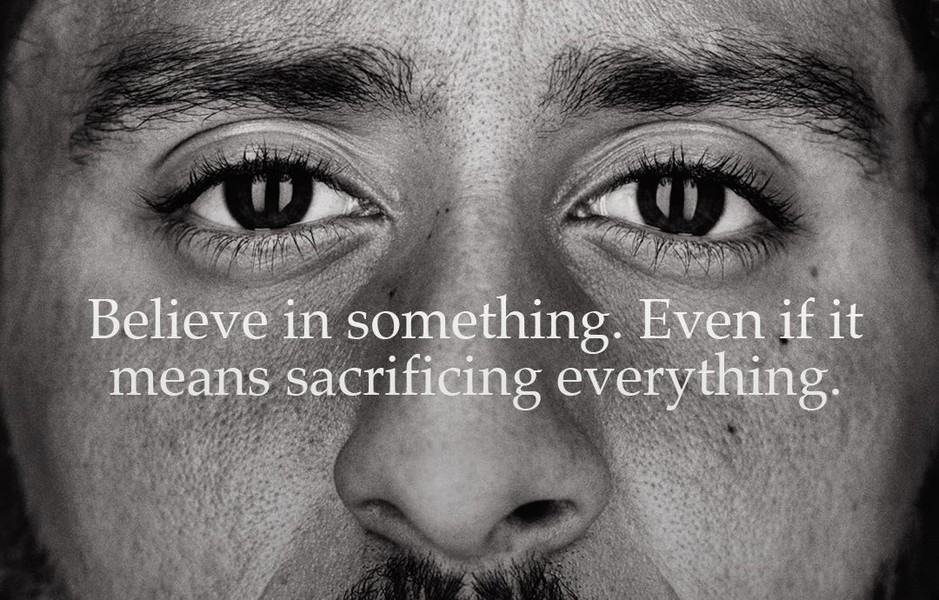
He has not played a game since 2016, but has since been on the cover of Time magazine. He has been called a ‘Son of a Bitch’ by no less the President of United States of America, who in the same speech, in his usual grandiloquent manner, announced “You’re fired.”And indeed, stayed on the bench the man has. He is Colin Kaepernick, an American football quarterback, a controversial figure in the US since 2016, after he chose to kneel while the US national anthem was being played before the start of NFL games. He was protesting against oppression and disproportionate killing of black people (and people of colour) in the US.
Then last week, Nike made him its face in their 30th Anniversary debut campaign. The campaign went viral, and all hell broke loose with protests and people burning their Nike products, vowing to boycott the brand for featuring Kaepernick. If you are reading this I am sure you know all about the campaign. So now, did Nike know that the campaign will go viral? Did they know they were inviting controversy? If indeed they did, why did they knowingly embrace it? Did they really have to do such a campaign?
Well, I would argue, not just is Nike the perfect brand to have done this campaign. But more importantly, the question is not even if it should have done such a campaign; the point is that it needed to do such a campaign.
It is not very difficult to answer these questions is you see the cultural landscape in which brands are operating today.
The power of one
One of the most significant changes that living in a connected world has brought to the human psyche is the sense of empowerment for the individual. In this world, social hierarchies have given way to an egalitarian structure where from an insignificant being earlier, s/she is able to engage with brands, with movie stars, with icons of Industry, with media heavy-weights, with giants of politics – in real-time, on a first-name basis – even call them names and take them to task. It’s like you know everyone and you can put your arm around anyone’s shoulders.
Even though the illusion of power this virtual proximity delivers is bigger than the power it really delivers, it has indeed made the individual more powerful than ever before, even in the real world. You may ask the mighty who have tasted dust.
From someone who had to be told who s/he was and what his place in this world was, the individual has come a long way. Today s/he is in the centre of the universe – s/he believes that the world s/he lives in revolves around her and that she can change the world.
A fire that burns
While these structures have empowered the individual in the virtual world, removing social structures and hierarchies enforced over centuries in the real brick and mortar world isn’t going to happen overnight – measurable change in society takes three generations to happen, they say. In the interim, a world unified by markets, is a world divided by beliefs. Black Lives Matter, Me Too, and many such initiatives around gender equality, LGBT rights, and others, are articulations of movements to change these disparities in social order.
And, the same social media that empowered the individual, along with mainstream media, is also key to an increased polarisation of the world. Consume, curate, create; only to be gamed by algorithms, which show people content (real and fake) similar to to their own views perpetuating, thanks to eco-chambers thus created, a confirmation bias and polarising the discussion further. Blame broken business model of media driven by eyeballs, or blame greedy politicians who thrive on divide and rule, fact is, a fire burns.
The result “politics is me and I am my politics.” It’s making people angry, but also fearful.
Everyone wants to look good; everyone wants to look smart
Said a really smart friend, summarising two key human desires today.
Everyone needs meaning in life and as citizens of this global community people have many shared causes to believe in. It’s not surprising then that one of the biggest stories of the digital revolution has been online activism.
On one hand has it has lowered the threshold for participation by making it incredibly simple to participate and propagate potentially unlimited causes. On the other hand it has also made this participation particularly gratifying, whether it is a feel-good in your own eyes, or in terms of social currency.
Who doesn’t want to be taller in their own eyes, or in the eyes of the others and to create a world more inclusive, more equal.
Enter Nike
In this fast changing world brands are really like living-breathing organisms embracing, thriving upon and driving change. Cultural brands like Nike don’t just recognise and understand changes in the social landscape, they also know how to bring people together around common causes.
I think Nike knew it had for too long focussed on just the individual and their capacity to go beyond own limitations. It understood that people today recognise their individual power, to go beyond the self; it recognised the seething disquiet and the people’s desire to stand tall in creating an equal world; and Nike understands the power of a connected world more than most other brands.
Data scientists today have all kinds of data – big and small – to accurately analyse connections, influence, reactions and make predictive recommendations. By pressing the right buttons in your messaging, content and dissemination strategies, you can create a variety of market response scenarios around your campaigns.
So, I am sure Nike knew that there were risks involved, but in asking people to rise above their fears, it had to rise about its own. Asking people to be bigger than just their sport, it had to rise above just being a business and be a brand that people love and would respect more. Well, it had to ask itself, not if its dreams are crazy, but if they are crazy enough.
To try and leap-frog again, it simply had to ‘Just do it’.
—–
On an aside, I believe, the campaign clearly designed to polarise, started with Serena Williams’ Catsuit controversy that went viral on social media a few weeks ago, continued with the beautiful video featuring Serena and her father and while it would be a bit extreme, and far-fetched ,to believe that Serena’s behaviour on court in the infamous Serena-Ramos controversy (which saw sharp reaction from feminists) was in any way motivated by the campaign, it did benefit the campaign keeping the torch aflame.
A version of this piece was published in Afaqs.
